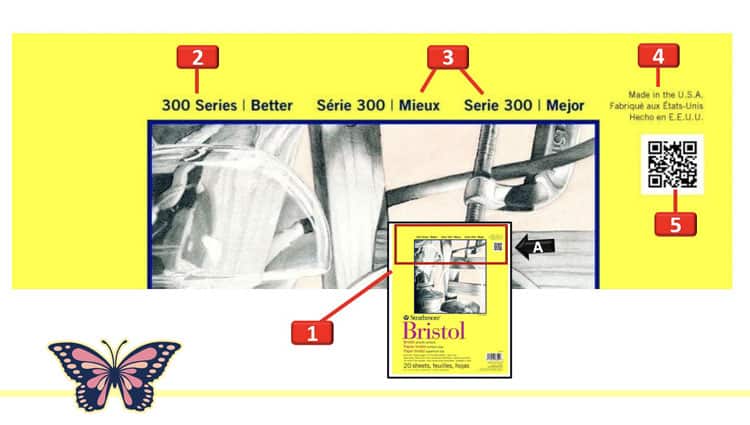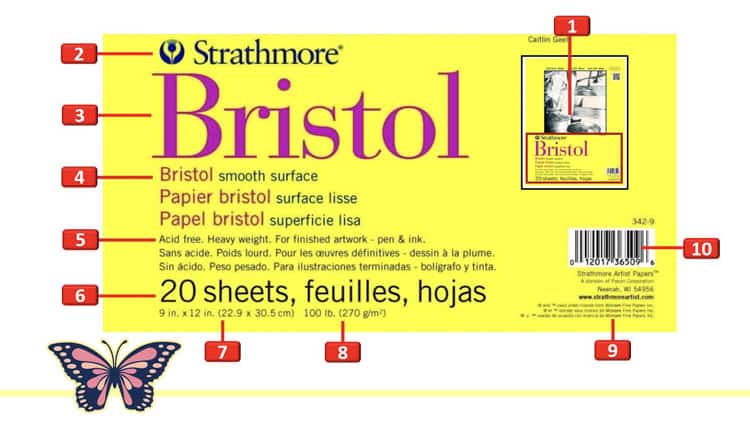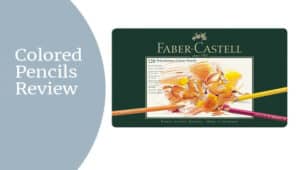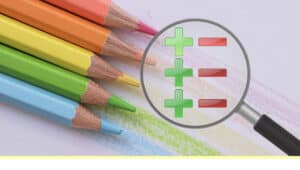
Understand paper specifications and their importance for adult coloring.
You are carefully been researching which paper to purchase for adult coloring. You have the brand name but what does all the information printed on the packing mean? What to know what it means? In this article, you are provided with the answers.
Paper Specifications
Table of Contents
- A Few Definitions to Remember
- Label Paper Specifications on Paper Reams
- Printed Paper Specifications on Paper Reams
- Printed Paper Specifications on Paper Pads
Other resources. Check out other supporting resources on ColoringButterfly.com that you might enjoy.
- How to Find the Best Colored Pencil Paper for Coloring (Guide)
- Which Coloring Books have Poor-Quality Paper? (2 Tips for Amazon)
- Buying A Coloring Book: Everything You Need to Know (Guide)
- Want Colored Pencil Paper? 13 Top Choices for Adult Coloring
- Adult Coloring Book Paper: Can It Make A Difference? (See How)
The information is printed on labels or the packaging as “specifications.” You will find this printed on the top or side of the paper container. Below are examples of different types of labels and what they mean.
- Important tip. Don’t toss the print label away; you can use the information (paper specifications) for quick reference the next time you reorder paper. [TOC]
Other supporting articles on ColoringButterfly.com that you might enjoy.
A Few Definitions to Remember
As we talk about paper specifications, you will run into terms that you may not have heard of. The following are among the most common for our discussion in this article.
Sheet size. Represents the size of the paper, and sheet size will usually be represented in inches and centimeters. Let’s look closer at the U.S. and European paper sizes.
- United States paper sizes. U.S. paper sizes are usually expressed in inches. The most common paper dimensions used in the United States are letter size (8.5 x 11 in). The following are the standard United States paper sizes.
- Half letter ( 5.5 X 8.5 in / 140 x 216 mm)
- Letter (8.5 x 11 in / 216 x 279 mm)
- Legal (8.5 x 14 in / 216 x 356 mm)
- Tabloid or Ledger (11 x 17 in / 279 x 432 mm)
- European paper Sizes. European paper sizes in millimeters. Europe’s most common paper size is A4 (210mm x 297mm). The following are the standard European paper sizes.
- A5 paper (5.8 X 8.3 in / 148 x 220 mm)
- A4 paper (8.25 x 11.7 in / 201 x 297 mm)
- A3 paper (11.7 X16.5 in / 297 x 420 mm)
- A2 paper (17.25 X 22.9 in / 594 / 841 mm)
Sheet Count. Represents the number of sheets contained within the ream or paper. A 500-sheet ream is considered the industry ‘standard.’ If the paper is thicker, you will see reams of 250 sheets. [TOC]
Recycled Content. This number references the percentage of recycled fiber used in manufacturing the paper. Recycled content comes from material collected from consumer waste streams, such as homes and offices. The most common is 30% recycled content, but 50% and 100% are also available.
Basis Weight. Weight refers to the thickness of the paper, and the higher the number, the thicker and sturdier the paper. The most economical option is 20 lb., used for everyday home and office printing. Heavier basis weights are sturdier to withstand repeated use, thicker for a more substantial feel and will minimize show-through with two-sided printing. [TOC]
Brightness. Brightness is usually in the range of 92-100. The higher the number, the brighter white the paper appears. Higher numbers equal more contrast between the sheet and the text and images – resulting in bolder images and brighter colors.
- 92 bright is suitable for everyday printing
- 94 to 96 bright and are well-suited to minimal color or two-sided printing.
- 98-100 bright is ideal for color-rich images, and graphics and for making text stand out. [TOC]
Label Paper Specifications on Paper Reams
In this example, I will share the meaning of the paper specifications that appear on the side of a ream of paper. The specifications on these types of labels can vary slightly per manufacturer, but the differences won’t change what is discussed in this example.

The following example comes from the side label of a ream of Neenah paper. The following are the paper descriptions/specifications of what each piece of information means on the label, and I have gone into some detail as needed.
1. Vellum Bristol. This defines the category of the paper. In this case, it is in the category of Vellum Bristol.
2. Brand. This is the name of the company (Neenah) that manufactures and sells paper. [TOC]
3. Color of Paper. The Paper inside this packaging is White.
4. Size. This information defines both the North American size in inches (11″ x 17″ in inches) and the European size in centimeters (278 X 432 cm).
5. Sheets. This number refers to the number of sheets of paper this package contains.
6. M Weight. This defines how much the paper weighs for 1000 sheets of paper. [TOC]
7. Vellum/Vellum. This defines the paper’s category and the type of paper surface. In this case, Paper Vellum Finish is used to describe the finished paper stock, and vellum finish describes paper treated with a fine-toothed texture. Another way of saying it is that the paper may appear smooth when looking at it straight on, but if you tilt it in the light, it reveals a fine, evenly applied rough finish.
8. Machine compatible. This information tells what type of printer this paper is best for. In this case, the paper is guaranteed to work in Laser printers, Inkjet printers and copy machines.
9. SKU number. When you go through the store check-out or online purchase, this is the number that is scanned.
- Used in retail. In the world of retail, SKU is likely one you’ve heard many times, but you may know the meaning. SKU stands for “stock keeping unit.”
- Meaning of SKU. It is a number (usually eight alphanumeric digits) that retailers assign to products to keep track of stock levels internally.
- Different SKU for each product variation. Each variation has a unique SKU number if a product has different colors and sizes. [TOC]
10. FSC Mix Paper. This FSC Mix Paper symbol means its paper product is made with mixed materials from FSC-certified forests, recycled materials, and FSC-controlled wood. While controlled wood doesn’t come from FSC-certified forests, it mitigates the risk of the material originating from unacceptable sources. There are several different FSC Labels. Click here to learn more about FSC symbols. https://fsc.org/en/what-the-fsc-labels-mean
11. URL and company information. This is the paper company URL where you learn more about the company and paper. It also includes other detail about the company
12. Model number 80213. This is the number that the company uses to tell them with the product is. In the case of this number (80213), the company uses the number to define this product as “Neenah 80213 Exact Vellum Bristol Medium Heavyweight Paper.” [TOC]
13. Recycling Symbol. This indicates that an object is capable of being recycled but not that it will necessarily be accepted in all recycling collection systems or that it has been recycled. Click here to learn more about this and related recycling symbols.
14. Acid-Free. Acid-free means the paper’s pH is 7.0 (neutral) or higher (alkaline). Acid-free papers will last up to 200 years under normal use and storage conditions. Due to its construction will not turn yellow with age and won’t get brittle like paper with a higher degree of acidity can over time.
- How it’s made. Acid-free paper is made from cellulose fibers, but the acid pulp of the fibers is removed during processing. Acid-free paper is also free from sulfur and lignin, an organic tissue in plant fibers that can turn paper yellow if not removed. [TOC]
15. Base weight 67lb/147 g/m2. This combination of a number refers to the weight of the paper. The first number is used for US weight. The second number is used for the European number. The higher the number, the heavier/thickness of the paper.
- US measurement. Paper weight in the US is stated in lbs. and is determined by weighing 500 sheets (a ream) in the basic size of a particular paper.
- European measurement. On the other hand, weighing paper in grams per square meter does give you a clean, apples-to-apples comparison. Measuring paper weight in grams per square meter (commonly referred to as gsm or g/m2) takes the weight in grams of 1 square meter of paper.
- Brightness. Often on paper labels/information, you will see the term “Brightness.” Brightness refers to the amount of light reflecting off a paper. When selecting paper brightness, think about what will be printed on it. Images printed on bright paper appear pretty vibrant. However, images of so-so quality may look washed out when printed on bright paper. [TOC]
Printed Paper Specifications on Paper Reams
In this example, I will share the meaning of the paper specifications printed on the top of a ream of paper. These types of printed specifications may be slightly different per manufacturer, but the differences won’t change what is discussed in this example.
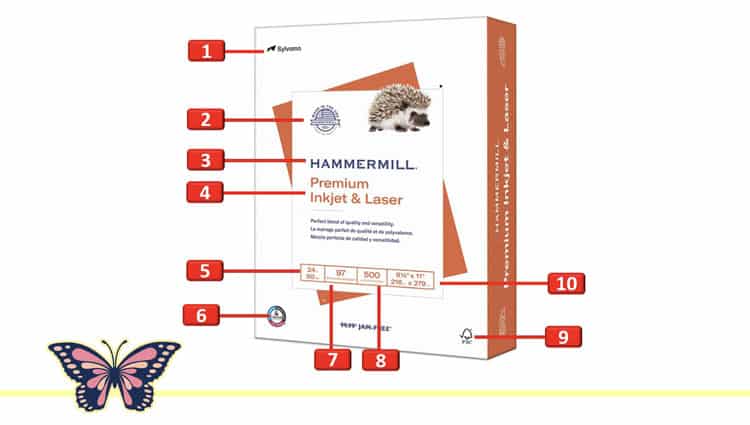
The following example comes from the front side of the Hammermill paper. The following are the paper descriptions/specifications of what each piece of information means on the label, and I have gone into some detail as needed.
1. Brand/Manufacture. This is the name of the company (Sylvano) that manufactures and sells paper.
2. Made in the USA. Hammermill created this symbol to denote that the paper is made in the USA and that the company has 100+ years of quality. [TOC]
3. Hammermill. Hammermill is a brand of Sylvano.
4. Machine compatible. This information tells what type of printer this paper is best for. In this case, the paper is guaranteed to work in Laser printers, Inkjet printers and copy machines.
5. Base weight 24lb/90 g/m2. This combination of a number refers to the weight of the paper. The first number is used for US weight. The second number is used for the European number. The higher the number, the heavier/thickness of the paper.
- US measurement. Paper weight in the US is stated in lbs. and is determined by weighing 500 sheets (a ream) in the basic size of a particular paper.
- European measurement. On the other hand, weighing paper in grams per square meter does give you a clean, apples-to-apples comparison. Measuring paper weight in grams per square meter (commonly referred to as gsm or g/m2) takes the weight in grams of 1 square meter of paper. [TOC]
6. Colorlok Technology symbol. What is ColorLok? ColorLok Technology is the new standard for better print quality. Paper that’s qualified with the ColorLok logo can produce the best possible digital prints. The ColorLok standard of performance is for plain-paper output with inkjet and laser printers, as well as common copy machines.
7. 97 Brightness. Often on paper labels/information, you will see the term “Brightness.” Brightness refers to the amount of light reflecting off a paper. When selecting paper brightness, think about what will be printed on it. Images printed on bright paper appear pretty vibrant. However, images of so-so quality may look washed out when printed on bright paper.
8. Sheets. This number refers to the number of sheets of paper this package contains. [TOC]
9. FSC Mix Paper. This FSC symbol means all materials used come from responsibly managed, FSC-certified forests. Products with the FSC 100% label contribute most directly to our mission to ensure thriving forests for all, forever. There are several different FSC Labels. Click here to learn more about FSC symbols.
10. Size. This information defines both the North American size in inches (8 ½” x 11″ in inches) and the European size in centimeters (216 X 279 cm).
11. SKU number. This ream has an SKU number but is not shown but is located in another region of the paper package. When you go through the store check-out or online purchase, this is the number that is scanned.
- Used in retail. In the world of retail, SKU is likely one you’ve heard many times, but you may know the meaning. SKU stands for “stock keeping unit.”
- Meaning of SKU. It is a number (usually eight alphanumeric digits) that retailers assign to products to keep track of stock levels internally.
- Different SKU for each product variation. Each variation has a unique SKU number if a product has different colors and sizes. [TOC]
Printed Paper Specifications on Paper Pads
In this example, I will share the meaning of the paper specifications printed on the top of a student/artist grade pad of paper. These types of printed specifications may be slightly different per manufacturer, but the differences won’t change what is discussed in this example.
The following example comes from the top of a “Strathmore Bristol Pad of Paper.” The following are the paper descriptions/specifications of what each piece of information means as it is printed on the paper pad. I have gone into some detail as needed. I have divided the description into the upper half and the lower half of the paper pad cover. [TOC]
Upper Half Paper Specifications for Paper Pad
This is the description of the top half of the Strathmore 300 Series cover.
1. Product Image. This is an image of what the front of the paper looks like. The area in red defines the area we are going to define.
2. Series 300 | Better. 300 Series – Better is a better-quality paper designed for quick studies and practice techniques with any media and final artwork by beginning or student artists. The “Series” is a form of product identification that Strathmore uses to categorize their fine art papers. This is used with the intent of helping the artist determine what Paper or Series best suits their needs. The Series also help clarify which level each of our papers fits into. Their Series numbers include:
- 100 Series – Youth
- 200 Series – Good
- Vision Series – Good
- 300 Series – Better
- 400 Series – Best
- 400 Series Recycled – Best
- 500 Series – Premium
3. Seri 300 | Mieux and Serie 300 | Mejor. The French and Spanish translations of “300 Series | Better.”
4. Made in the USA. Identifies where the product is made.
5. QR Code. When you scan the QR code with your phone, you receive information. The QR code in this example was the company URL for Strathmore 300 series paper, https//sappaper.com/300brist (which did not work). [TOC]
Lower Half Paper Specifications for Paper Pad
This is the description of the lower half of the Strathmore 300 Series cover.
1. Product Image. This is an image of what the front of the paper looks like. The area in red defines the area we are going to define.
2. Brand. This is the company (Strathmore)that manufactures and sells paper.
3. Bristo. This defines the category of the paper, and in this case, it is in the category of Vellum Bristol. The English “Bristol smooth surface” information below is the French and Spanish translations. [TOC]
4. Bristol Vellum– This defines the paper’s category and the type of paper surface. In this case, Paper Vellum Finish is used to describe the finished paper stock. Vellum finish describes paper treated with a fine-toothed texture. Another saying is that the paper may appear smooth when looking at it straight on, but if you tilt it in the light, it reveals a fine, evenly applied rough finish.
5. Acid-free. Acid-free means the paper’s pH is 7.0 (neutral) or higher (alkaline). Acid-free papers will last up to 200 years under normal use and storage conditions. Due to its construction will not turn yellow with age and won’t get brittle like paper with a higher degree of acidity can over time.
- How it’s made. Acid-free paper is made from cellulose fibers, but the acid pulp of the fibers is removed during processing. Acid-free paper is also free from sulfur and lignin, an organic tissue in plant fibers that can turn paper yellow if not removed.
- Heavy weight. For finished artwork—pen & ink. In this pad of Paper, Strathmore tells you that the paper is “Heavy Weight “or thicker Paper (see the description of base weight). Strathmore also recommends that this paper is best or ideal for “Finish artwork—pen & ink.”
- French and Spanish. The information found below the English wording “Acid-free. Heavy weight. For finish artwork—pen & ink” are the French and Spanish translations. [TOC]
6. Sheets. This number refers to the number of sheets of paper this pad contains.
7. Size. This information defines both the North American size in inches (9″ x 12″ in inches) and the European size in centimeters (29.9 X 30.5 cm).
8. Base weight 100 lb/270 gsm g/m2. This combination of a number refers to the weight of the paper. The first is for US weight, and the second is for the European number. The higher the number, the heavier/thickness of the paper.
- US measurement. Paper weight in the US is stated in lbs. and is determined by weighing 500 sheets (a ream) in the basic size of a particular paper.
- European measurement. On the other hand, weighing paper in grams per square meter does give you a clean, apples-to-apples comparison. Measuring paper weight in grams per square meter (commonly referred to as gsm or g/m2) takes the weight in grams of 1 square meter of paper.
- Brightness. Often on paper labels/information, you will see the term “Brightness.” Brightness refers to the amount of light reflecting off a paper. When selecting paper brightness, think about what will be printed on it. Images printed on bright paper appear quite vibrant. However, images of so-so quality may look washed out when printed on bright paper. [TOC]
9. URL and company information. This is the paper company URL where you learn more about the company and paper. It also includes other detail about the company
10. SKU number. When you go through the store check-out or online purchase, this is the number that is scanned.
- Used in retail. In the world of retail, SKU is likely one you’ve heard many times, but you may know the meaning. SKU stands for “stock keeping unit.”
- Meaning of SKU. It is a number (usually eight alphanumeric digits) that retailers assign to products to keep track of stock levels internally.
- Different SKU for each product variation. Each variation has a unique SKU number if a product has different colors and sizes. [TOC]
If you like this article, please share it with others.

